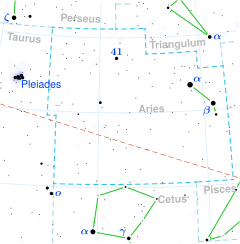아리에티스 에타
Eta Arietis| 관측 데이터 에폭 J2000 이쿼녹스 J2000 | |
|---|---|
| 별자리 | 양자리 |
| 우측 상승 | 02h 12m 48.08568s[1] |
| 탈위임 | +21° 12′ 39.5776″[1] |
| 겉보기 크기 (V) | 5.231[2] |
| 특성. | |
| 스펙트럼형 | F5 V[3] |
| U-B색지수 | –0.04[4] |
| B-V색지수 | +0.44[4] |
| 아스트로메트리 | |
| 방사 속도 (Rv) | +4.5km[2]/s |
| 고유 운동 (μ) | RA: +1909.17마스[1]/yr Dec.: +5.000[1]mas/yr |
| 시차 (π) | 33.383 ± 0.1196[1] 마스 |
| 거리 | 97.8 ± 0.4 ly (30.0 ± 0.1 pc) |
| 절대치수 (MV) | +2.93[2] |
| 세부 사항 | |
| 미사 | 1.21[5] M☉ |
| 반지름 | 0.98[6] R☉ |
| 표면 중력 (log g) | 4.01[3] cgs |
| 온도 | 6,380[3] K |
| 금속성 [Fe/H] | –0.35[3] 덱스 |
| 회전 속도 (v sin i) | 초속[7] 9km/s |
| 나이 | 2.6 Gyr[2] 3.98[5]Gyr |
| 기타 지정 | |
| 데이터베이스 참조 | |
| 심바드 | 자료 |
에타 아리에티스(Eta Arietis)는 아리에티스(Arietis)에서 라틴어로 표기된 것으로, 아리에티스(Aries) 북쪽 별자리에 있는 별을 바이엘(Bayer)로 명명한다.외관상 5.231의 시각적 규모로 육안으로 희미하게 보인다.[2]연간 시차 이동이 33.34마스인 경우,[1] 이 별과의 거리는 약 97.8광년(30.0파섹)이다.방사상 속도 +4.5 km/s로 더 멀리 떠내려가고 있다.[2]
이것은 F5 V의 별 분류를 가진 F형 주계열성이다.[3]약 26억 년의 나이로 태양보다 젊다.[2]외부 대기의 유효 온도는 6,380 K로 [3]F형 별의 황백색 후두 빛을 발한다.궤도를 선회하는 동반자에 의해 야기될 수 있는 방사상 속도 변화에 대해 HARPS 기구를 사용하여 Eta Arietis를 검사했지만, 어떤 신호도 감지되지 않았다.[8]또한 스피처 우주 망원경을 사용한 적외선 초과도 감지되지 않았으며, 이 망원경은 그렇지 않으면 항성 가스나 먼지의 존재를 나타낼 수 있다.[9]
참조
- ^ a b c d e f Brown, A. G. A.; et al. (Gaia collaboration) (August 2018). "Gaia Data Release 2: Summary of the contents and survey properties". Astronomy & Astrophysics. 616. A1. arXiv:1804.09365. Bibcode:2018A&A...616A...1G. doi:10.1051/0004-6361/201833051.이 소스에 대한 가이아 DR2 기록 VizieR.
- ^ a b c d e f g Holmberg, J.; Nordström, B.; Andersen, J. (July 2009), "The Geneva-Copenhagen survey of the solar neighbourhood. III. Improved distances, ages, and kinematics", Astronomy and Astrophysics, 501 (3): 941–947, arXiv:0811.3982, Bibcode:2009A&A...501..941H, doi:10.1051/0004-6361/200811191, S2CID 118577511.
- ^ a b c d e f Cenarro, A. J.; et al. (January 2007), "Medium-resolution Isaac Newton Telescope library of empirical spectra - II. The stellar atmospheric parameters", Monthly Notices of the Royal Astronomical Society, 374 (2): 664–690, arXiv:astro-ph/0611618, Bibcode:2007MNRAS.374..664C, doi:10.1111/j.1365-2966.2006.11196.x, S2CID 119428437.
- ^ a b c "eta Ari". SIMBAD. Centre de données astronomiques de Strasbourg. Retrieved 2012-08-04.
- ^ a b Luck, R. Earle (January 2017), "Abundances in the Local Region II: F, G, and K Dwarfs and Subgiants", The Astronomical Journal, 153 (1): 19, arXiv:1611.02897, Bibcode:2017AJ....153...21L, doi:10.3847/1538-3881/153/1/21, S2CID 119511744, 21.
- ^ Pasinetti Fracassini, L. E.; et al. (February 2001), "Catalogue of Apparent Diameters and Absolute Radii of Stars (CADARS) - Third edition - Comments and statistics", Astronomy and Astrophysics, 367 (2): 521–524, arXiv:astro-ph/0012289, Bibcode:2001A&A...367..521P, doi:10.1051/0004-6361:20000451, S2CID 425754.
- ^ Takeda, Yoichi; et al. (February 2005), "High-Dispersion Spectra Collection of Nearby F--K Stars at Okayama Astrophysical Observatory: A Basis for Spectroscopic Abundance Standards", Publications of the Astronomical Society of Japan, 57 (1): 13–25, Bibcode:2005PASJ...57...13T, doi:10.1093/pasj/57.1.13.
- ^ Lagrange, A.-M.; et al. (February 2009), "Extrasolar planets and brown dwarfs around A-F type stars. VI. High precision RV survey of early type dwarfs with HARPS", Astronomy and Astrophysics, 495 (1): 335–352, arXiv:0809.4636, Bibcode:2009A&A...495..335L, doi:10.1051/0004-6361:200810105, S2CID 62894956.
- ^ Trilling, D. E.; et al. (February 2008), "Debris Disks around Sun-like Stars", The Astrophysical Journal, 674 (2): 1086–1105, arXiv:0710.5498, Bibcode:2008ApJ...674.1086T, doi:10.1086/525514, S2CID 54940779.


